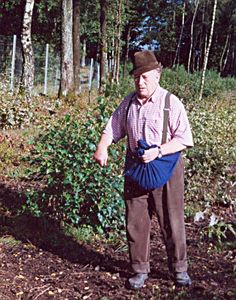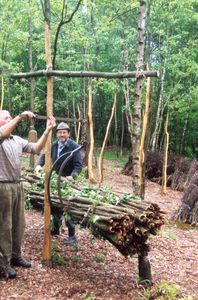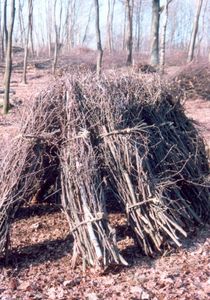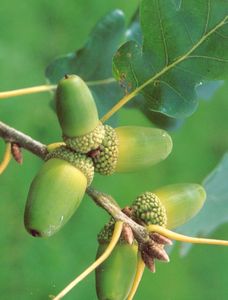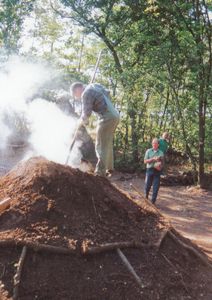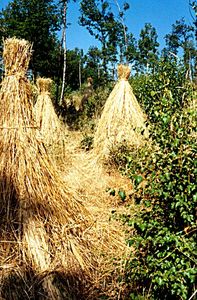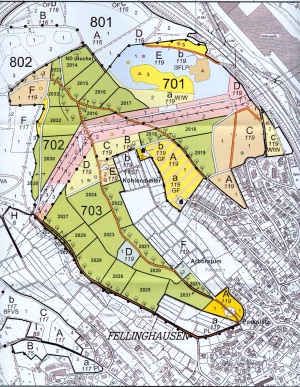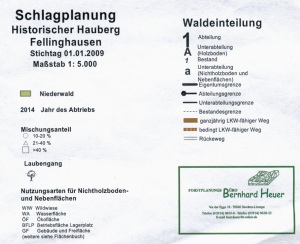The Historical Hauberg
The following paragraph is a quote from (Becker, A: Der Siegerländer Hauberg, 1991) in a revised version compared to that of the publication:
The former multi functional economy of the Hauberg has lost its reason for existence. Therefore it cannot be continued on larger areas, except as firewood coppice woods.
Nevertheless, it is in the interest of care of traditions, documentation, the teaching in school classes, and research, to maintain at least a small area on the historic base and continue or revive, respectively, the Hauberg in its traditional form.
Economic conditions, particularly the ratio of the values of building to fire wood, generally enforce a conversion of Hauberg coppice into high forest. This is true at least since the end of the 19th century. This goal Hauberg collectives and forest authorities have pursued. Compared to earlier predictions (e.g. DOEPNER, SZ v. 05.30.1973) the pace of conversion has slowed down considerably and the expected ratio of deciduous to coniferous high forest has shifted in favor of the deciduous forest. Doepner predicted in 1973 that the conversion of coppice forests in 2000 will be substantially completed and that at this time approximately 70% of the forest area would consist of coniferous forest, whereas deciduous forest would contribute about 30%.We see today that in the year 2000 still about 6,000 to 7,000 hectares of forest will be present in the Siegerland and the area of deciduous and coniferous trees will be about the same.
Another significant change in the expected development has occurred in that more and more voices were heard pleading for the preservation of the low forest, at least on partial areas.
The reasons for this recommendation are varied:
Requirements of soil and water protection, habitat and species protection, but also the goal of preserving a historically significant part of an economic area and an in many respects unique cultural landscape.
As early as 1964, in the Siegerländer Heimatkalender, p.145, the following note can be found under the heading Flowering Crab Apple Tree (Blühender Wildapfelbaum): Scientific authorities already feel today the loss that the chance has been missed to systematically document the entire Haubergswirtschaft throughout the year - deviding, tanbark stripping, hoeing, grass fire, the sowing of the crop , the young shoots, ripening of the grain, harvest, etc. in photograph. What a wealth of pictures for the archives, for research and for future generations this would have been!
Professor ROMELL from Sweden, wrote in an essay on Reutbetriebe and their mystery in Studium generale, quoted in SHK 1969, p.133/134: Today there is no longer shifting cultivation (Geschwendbau) in the Hauberg, and not a broom appears on the clearcuts. Instead, wavy hair-grass grows and flowers as dense as rye seed. One hopes something from such a unique cultural monument, which is also ofoutstanding ecological interest, something could be preserved, at least in museum form.Professor Dr. Jost Trier elaborates 1962 in Wood. Etymologies of the coppice, also reproduced in the SHK 1969, pp. 134, among other things: May ... the Krombacher Hauberg and that of Littfeld which have given us a lot of happy intuition, not be converted into spruce plantations. May also insightful men elsewhere ensure that the low forest management, this living witness of speach formative old-time, does not disappear entirely from the German landscape.
As an unpublished manuscript by Dr. Martin Denker (1974) shows, with which he developed a cost estimate for conducting historical Hauberg works, shows that there was planned a Museumshauberg near the community of Burbach was planned. The report was filed on behalf of the Lower landscape office (Untere Landschaftsbehörde).
Josef HOFFMANN (The Haubergswanderer) wrote in 1985 in issue 10 of the publication series of the Wilhelm Münker Foundation, Before the last Hauberg falls should - this suggestion will find open hearts - a terrain somewhere in the Haubergs area should be selected on which, after 2500 years of existence, a piece Haubergswald is -as elsewhere a piece of heather or bog- preserved for posterity, which is hewn traditionally in bands in the usual alteration, but otherwise retains an image of the old Hauberg with all of the tree, shrub and plant species, as are characteristic for the Hauberg. That would remind the descendants of Hauberg people -and not only these- of what the Hauberg was through 2500 years.
The following appeal is already included in the 1959 printed book HOFFMANNS Wild Roses in the Hauberg, p.369: Remarkably, in this (probably original) version before the last sentence the followin -inserted- sentence can be read: This singular protected forest would be a documentary, a museum that continues the Hauberges, whose nature and form we know.Professor OLTERSDORF bemoans in 1987 in his essay The consequences of industrial development in rural areas of the Siegerland, that there was no room for the revival of e.g. a Hauberg or an irrigation meadow area.
Professor Dr. Richard POTT, during a study tour of the Forestry Association of North Rhine-Westphalia in June 1989 in the eastern and southern Siegerland, has proposed a revival of the old Hauberg economy on a small area and given as ana explanation: Not because of the nature conservation, but as a museum. The Siegerländer Hauberg economy will be of interest to scientists from countries around the world. Colleagues from across the European countries, America, and Australia come here into the Siegerland to see the exemplary use and alteration of the forest by the people.
A year later, Professor POTT writes in Issue 28 of the publication series of the Wilhelm Münker Foundation: But also a few characteristic Hauberg areas should continue to be managed in a traditional way to preserve this unique form of South Westphalia hill forest land as cultural and historical heritage.
Elsewhere, the idea of a museum forest has already been realized, for example, on the Hönggerberg in Zurich, where in a joint project of ETH Zurich and the city forestry department of the medieval forest form Mittelwald (coppice) in the so-called experimental forest has risenagainand has beenmade available to the population and to young students.As was noted during a visit of the experimental forest end of April 1992, the population is not at all impressed by its recent hewing measure (blow smote off the wood and removal of some top rack). Also an indication of the expected relatively quickly revegetation was not quite accepted.
Another significant form of coppice management, the Reutefeld economy in the Black Forest, has at least found a worthy representation in the forest museum in the Black Forest Open Air Museum Vogtsbauernhof (see BERNAUER, 1989).
Until the achievement of a comparable project in the Siegerland, considerable administrative difficulties had to be overcome. Since the contract has been concluded on 21 December 1991, a Historical Hauberg is now secured -at least for the contract period of 10 years:
The Contract
In the absence of a suitable area in public ownership, a contract between the State of North Rhine-Westphalia (State Forestry Administration), and a forest cooperative was closed in the northern Siegerland. This agreement commits the forest cooperative Fellinghausento continue the whole complex of the historical use of the Haubergon a partial area of about 24ha of their forest property, withan annual 0.5 ha within this area. The country pays a compensation for giving up more profitable high-forest use andthe additional laborcaused by the management in a historical form.That of all the forest for Historical Hauberg the Waldgenossenschaft Fellinghausen was selected is related to the fact that in this forest association still plenty of areas with young, Hauberg able to sprout were present. It is a curious coincidence that Fellinghausen (Weiden) from 1833 until his death on Feb 9th, 1849, was the residence of Charles Frederick SCHENCK, the author of the Statistics of the County Siegen in 1820, in which he devoted the Hauberg economy least 40 pages.
For the contract area, a new hew division and hew series plan was developed, a special operating plan worked out, and a concept for the organization of the proceedings created.
The contract area is accessible to everyone. Signs and leaflets inform about the details of the project. Group tours can be made to order. Documentations regarding technical processes, working practices, clothing and costumes are apreciated, suggestions are very welcome. Contact addresses for applications, etc. are, after the last reorganization of forest land in North Rhine-Westphalia:
Regionalforstamt Siegen-Wittgenstein
Vormwalderstr.9
57271 Hilchenbach
Tel. 02733/89440Waldgenossenschaft Fellinghausen
Waldvorsteher Dr. Bernhard Kraft
Auf dem Hainchen 10
57223 KreuztalFörderverein Historischer Hauberg Fellnghausen e.V.
Herr Ulrich Gießelmann
Landstraße 101
57223 Kreuztal
A tabular summary of the first 10 years of historical Haubergs be found here.
The Fellinghäuser Hauberg has become a highly regarded and well-attended open-air museum, as e.g. ZIMMERMANN (1993) states. The brochure 25 Jahre Kreuztal, Stadt am Kindelsberg, (1994, Ed. Stadt Kreuztal) recognizes the Historic Hauberg Fellinghausen on 2 pages.
A comprehensive photo documentation about the Historic Hauberg, representing both the individual activities in the Hauberg and the ecological characteristics and functions of the coppive woods, has been published in 1995 as the first of a series of publications of the State Forestry Administration NRW (Landesforstverwaltung NRW) titled BILDER AUS DEM HAUBERG.
